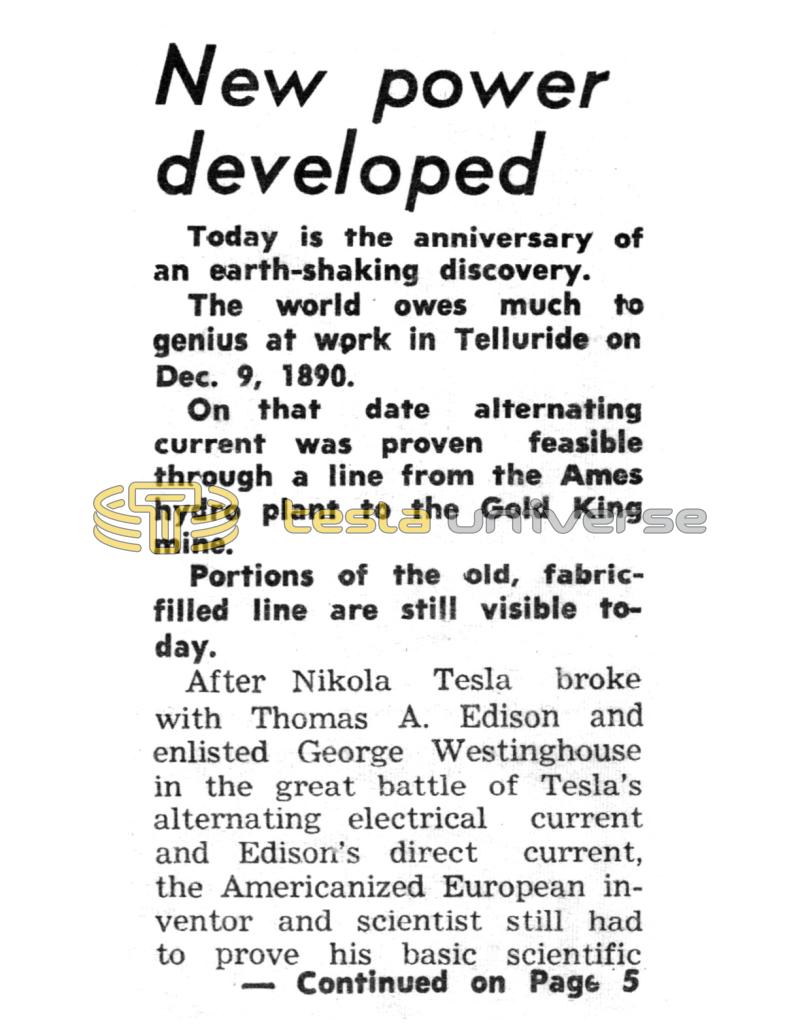
Nikola Tesla Articles
New Power Developed - Ames, Gold King and the Nunn Brothers
Today is the anniversary of an earth-shaking discovery.
The world owes much to genius at work in Telluride on Dec. 9, 1890.
On that date alternating feasible current was proven through a line from the Ames hydro plant to the Gold King mine.
Portions of the old, fabric-filled line are still visible today.
After Nikola Tesla broke with Thomas A. Edison and enlisted George Westinghouse in the great battle of Tesla's alternating electrical current and Edison's direct current, the Americanized European inventor and scientist still had to prove his basic scientific concepts to the world. Industrialists of America and Europe were cool to Tesla's ideas, but the historic break-through came in Telluride.
Tesla and Westinghouse joined the Nunn brothers, Lucien and Paul in developing alternating electrical generators to solve the problem of combatting high production costs in the Gold King Mine near Telluride in 1890.
Lucien Nunn followed the mining excitement from Leadville to Durango and finally Telluride. He combined his efforts as lawyer, carpenter and restauranteur to keep body and soul together. Having the first bath tub in Telluride, he also had a lively weekend business renting the tub at 50 cents per bath.
Nunn became manager of the Gold King and soon was faced with the problem of closing the mine or finding cheap power. As the mine went deeper fuel became more costly and scarce. Timber near the high altitude tipple had been sumed. Coal cost $50 a ton and had to be packed in on the backs of burrros. Nunn sent for his brother, Paul, an engineer in New York.
BROTHERS GAMBLED ON TESLA'S IDEAS
The Nunns were aware of the eastern power controversy, and decided to gamble on Tesla's ideas. Beside a stream 2.6 miles away, the Nunns installed a six-foot Pelton water wheel to which was attached a 100-horsepower 133-cycle, single-phase, 3,000-volt generator. At the mill end of the line a complementary motor was installed. Generator and motor were Telso-patented productions by Westinghouse even added $25,000 to carry out the experiment.
Early in 1891, the system of generating and transmitting alternating current was in operation. Lightning arresters were improvised. The problem of training men to operate and maintain the revolutionary equipment was solved when the Nunns established the Telluride Institute. Student engineers from Cornell and young men from the Colorado frontier were enrolled in America's first on-the-job training program established by a corporation. They were furnished a technical library, shops and a laboratory where they learned about alternating current along with other existing knowledge of electricity. They received room, board and $30 a month.
The young electricians found many practical methods of using electricity. Rattlesnakes kept crawling into their power house, so the embryo scientists placed metal plates in the snake crawl area. They electrocuted the first intruding snake, but also knocked out the plant with a short circuit.
TELLURIDE INSTITUTE TRANSPLANTED
The Nunns did more than prove Tesla's theories and introduce power transmission. The Telluride Institute they started still exists. After seven years at Telluride, it was transplanted to the Cornell campus. at Ithaca, N.Y. Annually 30 young men are given scholarship to live at Telluride House.
L. L. Nunn also endowed the Deep Springs School in California.
The successful Tesla project at Telluride aroused the engineering world. Within a year, the Edison company had a direct current power station in Red Canyon Creek to serve the Virginius Mine near the summit of Mount Sneffels in the Ouray district.
While the country was paying tribute to Telluride for having the first power station in the world to transmit alternating current at high voltage for power purposes, Tesla was busy perfecting the Tesla coil.
